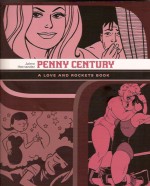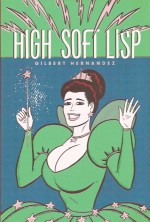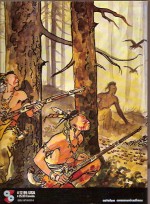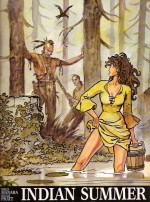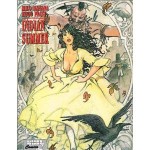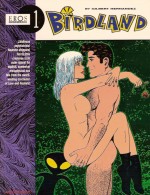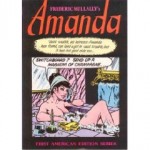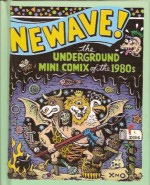
By various, edited by Glenn Head (Fantagraphics Books)
ISBN: 978-1-60699-288-3
The third magnificent, oversized compendium of cutting edge cartooning and alternative artistic visions has finally arrived and once more combines famed and possibly less well-known creators in a bold, brassy high-quality, giant-sized (9×12 inch or 230x304mm) full colour and black and white anthology of new tales and concoctions. There’s even a multi-page psychedelic, phantasmagorical fold-out ‘The Magnificent Pigtail Show’ from the incredible Steven Cerio.
Beginning with art-pieces – David Sandlin’s ‘Studio of Sin’ and Tim Lane’s ‘Greetings From Hotwire USA’ – the sequential narratives launch with Michael Kupperman’s ‘Meet McArf!’, a decidedly smooth shaggy dog story, the eerie childhood reminiscence ‘Car-Boy’s Family’ from Max Andersson and ‘Bottomless’ a salutary tale of excessive appetite from Eric Watkins and Chadwick Whitehead.
The first of a series of ‘Feral Spheres’ – monochrome artworks by David Paleo – is followed by ‘Denial’ and ‘The Bully’, two moody introspections from Jayr Pulga and Sam Henderson’s gross-out gag-strip ‘At a Frat Party or a Sports Game or Something Like That’, before editor Glenn Head enthrals with the cheery chiller ‘Candyland Clinic.’
After Paleo’s second ‘Feral Sphere’ the always fascinating Mary Fleener describes how and why she bought a gun in ‘The Judge’ and Rick Altergott reveals the sordid saga of a sweet young thing who was just too ‘Keen on a Clown!’, after which sordid shocks Head returns with some ‘Psychedelic Smut’.
Onsmith’s beguiling ‘Dispossession by Tornado’ is followed by another ‘Feral Sphere’ and Mark Dean Vega reinterprets some of our most beloved comics characters in his mouth-watering ‘Popeyeconography’ before Doug Allen’s grotesquely funny ‘Hillbilly’s Dun Gawn Ta College’ and the ever offensive Johnny Ryan provides insight to life with ‘The Cockhorns’.
Following the aforementioned Cerio foldout section Tim Lane crafts a chilling tale of hobos riding the rails in ‘Spike’, Danny Hellman illustrates a truly lovely clash in ‘Alice Versus the Sandman’, R. Sikoryak retells the story of Hamlet using Hank Ketcham’s oddly appropriate cartoon cast in ‘The Menace of Denmark’ and Mack White provides a surreal and terrifying glimpse into ‘Roadside Hell.’
Another ‘Feral Sphere’ precedes, for my money, the very best piece in this collection. The darkly mannered tale entitled the ‘Passion of Atte’ by Matti Hagelberg is a complex, brooding tale of vanishment and suicide – or is it?
‘Infernal Combustion’ is a bold, old-fashioned paranoid nightmare by David Sandlin, followed by one last ‘Feral Sphere’ and Danny Hellman’s delightful ironic parable ‘Tales of the Sodom Ape Men and the Electronic God’, Stephane Blanquet provides so much more than just a ‘Drawing’, Karl Wills delivers a punchy space fable in ‘Connie Radar’ and Mats!? chills and thrills with his deeply disturbing discourse ‘Sleep Walker.’
The final tale is the classy history of an unsung hero from another, more wicked time:Â Glenn Head relates the rather sad and nasty tale of ‘Vulvina, the Ventriloquist’s Dummy Daughter!’ which closes another startling, offensive, compelling and thoroughly wonderful box of cartoon delights for brave, hungry souls in search of different kicks. Strictly for those of you over voting age, this is a treat no real comics aficionado can afford to miss.
All artwork and stories © 2010 the respective creators. All rights reserved.



